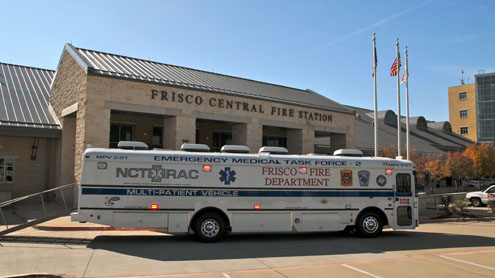

Sartin conversions changing mass casualty transportation
By Glenn Swain
Ed Sartin and his son, Austin, of High Point, NC were watching the national news reports of the large numbers of fatalities during Hurricane Katrina in August 2005 and came up with a revolutionary idea that has changed the way emergency responders look at mass casualty transportation.
Over the next year the Sartins developed a unique conversion process called the Medical Ambulance Bus (MAB)® that turns a bus or other vehicle into a fully-equipped advanced life support vehicle capable of transporting up to 24 patients on stretchers or up to 10 wheelchairs. The Medical Ambulance Bus easily accommodates patient volumes that usually require entire ambulance fleets.
These multi-purpose vehicles are custom designed to handle any mass casualty or evacuation event and come equipped with the latest in advanced life support equipment. A MAB is ready to roll at an instant’s notice, possessing all the features required for operating unsupported for several days. Agencies in the Washington, D.C. area were the first to order the buses. Currently, there are more than 60 MABs in production or already delivered to cities across the U.S.
“When the federal government and local and state agencies found out the MABs are a tremendous asset for the emergency responders, the number of buses ordered has rapidly increased,” says Ed Sartin, owner of Sartin Services. “We just delivered one to Seattle, so we’re on the West Coast now, and we have received an order for four buses for FDNY in New York City.”
Sartin Services has been in the bus conversion business for nearly 30 years and has manufactured buses and completed custom conversions for EMS and fire departments throughout the U.S. Over the past six years the company has used its extensive experience to develop and refine the Medical Ambulance Bus concept.
Sartin Services builds its MAB vehicles on both new and used chassis, since as many customers stipulate only new equipment be used. For others, a MAB on a used late-model bus or and RV body/chassis makes better economic sense. Local school districts have also donated buses to local emergency response agencies for a conversion.
As emergency department budgets shrink and demand for comprehensive emergency response grows, many agencies face difficult decisions. The ability to save as much as 30 to 50 percent on the initial purchase price of a used vehicle body/chassis and still not lose any functionality is very appealing in the current economic climate.
A bus Sartin Services converted into an ambulance bus bears little resemblance to its former self. Essentially, it is transformed into a fully functioning ambulance in every sense.
The conversion process starts by removing the seats and installing a new germ and virus resistant floor. Technicians also address any body/chassis issues, dents and blemishes during the conversion process. The vehicle is outfitted with features such as a custom manufactured sliding/stacked stretcher system that provides each patient with an individual metered oxygen supply. The bus also includes a loading ramp, an oxygen storage and distribution system, as well as medical storage compartments, generator and a climate control system. The windows are paneled over inside and outside the bus.
The emergency exit door at the rear of the bus is modified for use as the main entry and egress point for stretcher-bound patients. Since one of the most common injuries among first responders is a back injury caused by poor patient lifting technique, the MAB bus conversion enlarges this door to accommodate full standing headroom, giving EMTs space to employ proper ergonomics. A ramp assembly allows patients to be rolled or carried into the vehicle.
With painting and installation of graphics, plus the addition of other specialty features, the fully operational unit for service emergency is ready for turn-key delivery.
Once the windows are paneled the work on the interior can begin. Wiring for 12- and 110-volt power is run to outlets placed throughout the bus.
The surface of the interior walls is covered with seamless dry-erase board material. This material gives hurried first responders a canvas to write down vitals and other information anywhere inside the bus. High output LED lights reflect the exact skin tone so EMTs can better evaluate patients, replacing the original interior lighting with emergency lights and siren also added.
As the particular needs of specific agencies and departments vary, Sartin designs each bus specifically for a customer’s precise needs with medical storage cabinets, closets, paramedic work stations and attendant seating installed around the stretcher system. The 10-foot ramp and ramp storage assembly mounts under the rear overhang of the bus.
For Ed Sartin and his employees, the satisfaction comes by helping others.
“When you go home at the end of the day you know that you’ve helped people and that’s what it’s all about,” Sartin says. “We’re a family company here, and we’re helping people we don’t even know. It’s a great feeling to know that we’re making a product that is beneficial to others.” BRM
